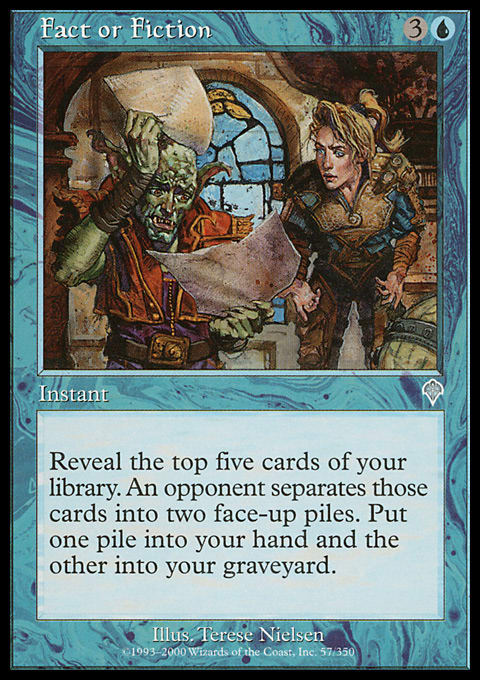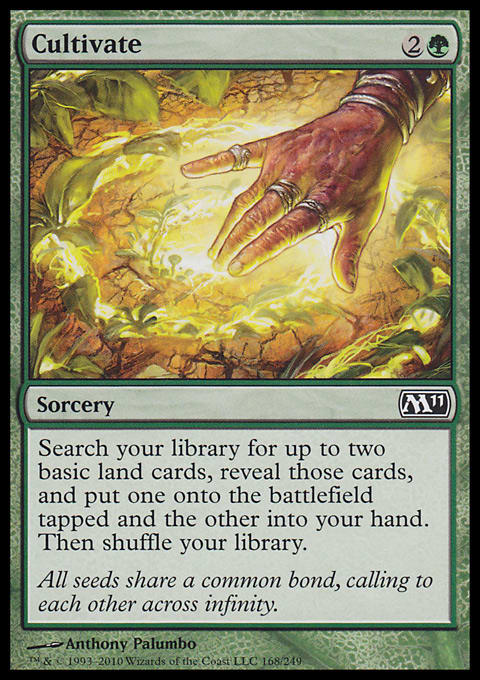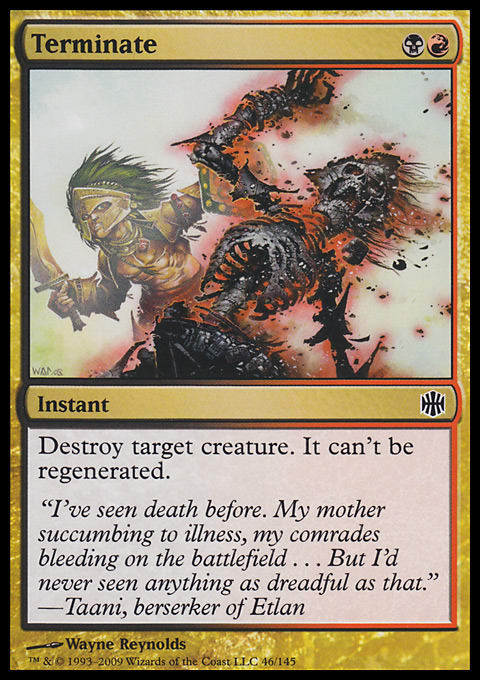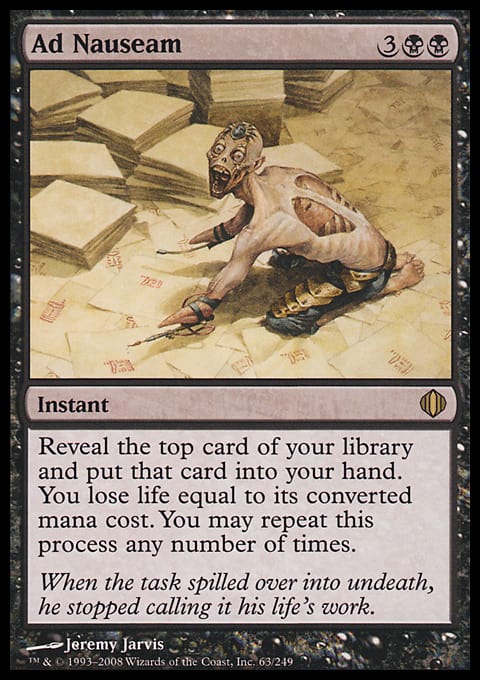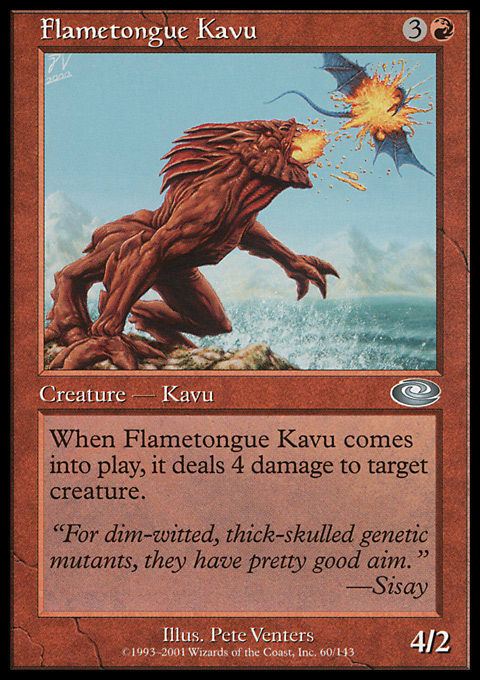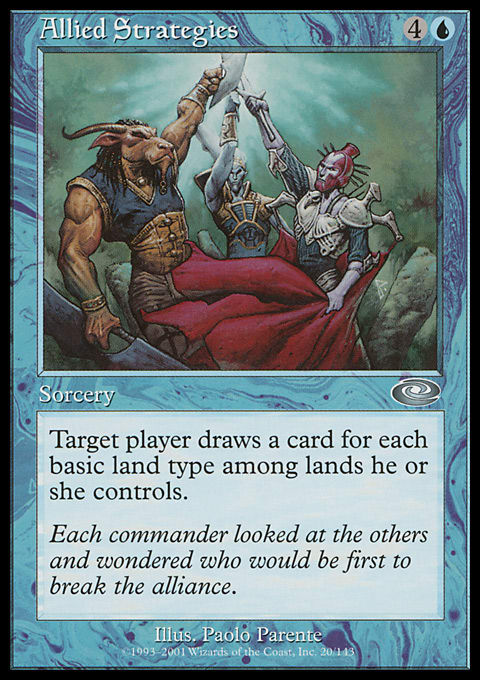When you first started playing, did you have a deck that was over a hundred cards? If you were like a lot of other folks, you may have had a giant deck. Today, we’ll discuss an online format that requires you to have a big deck—just like the old days!
I want to talk about the online format known as Prismatic. Based on the old format of Five Color, but with some important differences, this casual format is my favorite to play online. There are several variants that others play as well, but we won’t look at them today. Instead, I want to write about Prismatic a bit, give you some ideas for powerful cards for the format for a low number of tickets, show you my current deck, and talk about the metagame and so forth.
As we mentioned last week, Prismatic is a casual online format that allows cards from any set online and requires at least two hundred fifty cards in your deck and twenty cards of each color. Due to the quirkiness of the format, it has its own banned and restricted list, which you can find here.
In order to start your first deck, I recommend you begin with an idea. What do you want your deck to look like? If you don’t care that much and want to just toss a bunch of favorites in, that’s fine! But most people want to have a deck with a concept. It can be as simple as control or aggro or as detailed as a Slivers Prismatic deck. Whatever your idea is, see what you have to flesh it out, and then begin to build the deck around that foundation.
Once you have that core, you can expand your cards. I like to begin with the most powerful cards in my idea. If I want a control deck, in go cards I own such as Fact or Fiction, late-game ending cards such as Iridescent Angel and an Akroma, and more. Don’t add the details yet. Skip Terminate, Swords, counters, land fetching, and so forth. Just pull the ten to forty cards in your collection that are the foundations of your deck.
After you have an idea of how your deck will grow, look at the colors included. Minimize two colors to the bare twenty cards. You might pull off three colors, but at least two should be on the small side. A multicolored card can only count for one color, not all of them. Now flesh out your deck slowly. I like to start with mana smoothing. In my modern-day decks, I don’t usually include green mana accelerants that don’t turn into two cards. I’m not a fan of Rampant Growth to just find me one land. I rely on Cultivate, Kodama's Reach, and Shard Convergence to tutor for lands. I also prefer cards such as Krosan Tusker, which cycles for a land and a card, and enters-the-battlefield (ETB) creatures, such as Solemn Simulacrum and Civic Wayfinder. Card advantage is important, even for these spells.
Then, move into your next level of cards for your strategy. If you are control, what defensive creatures do you have and play? If you are aggro, what good cheap creatures are available? This is where you add in the Diregraf Ghouls and Wall of Omens. Flesh out your colors.
Now add card-drawing, removal for various permanents, and anything else that fits into your deck. Some may want tempo elements, others bounce, and more are desirous of counters. Add things to your deck. Emphasize cards with single colored mana requirement over those with two. It’s easier to cast Mana Leak than Counterspell. Unless I have a deck with a ton of blue mana due to an emphasis on that color, I try to steer away from early-game cards that have a double-color cost.
Then, add lands, and either pare down to two hundred fifty or add up to it. You may need to ensure that you have twenty cards of each color. Removal that is gold in a color of emphasis is nice. For example, in a deck that minimizes red but emphasizes black, Terminate is a fine choice to round out your red. You’ll find cards from your collection to fit.
Once you have your deck, go play! Due to the online game, you will never have to shuffle a deck this size, and that’s a huge bonus. So go play!
In any casual format, you’ll come across two sorts of decks because people have two ways of approaching the format. The first is to play by the rules and concept of the format and hew to the idea of it. When you play Commander, you grab a flavorful legendary creature and build a deck around it. However, it’s important to understand that there is a group of players who will take any casual format and try to abuse it to be something it is not intended to be.
For example, I recently faced a mono-red deck with Blood Moon and Magus of the Moon in a Prismatic game. How did that happen? All of the cards that counted for other colors were hybrid with red. He used the hybrid rules to play all four colors without playing one. To be fair, people did that before hybrid with cyclers and split cards, but those decks weren’t as good. Sometimes people abuse the rules to create a deck that doesn’t fit the style or idea of the deck.
Last week, I was playing Commander online and ran into a guy who piloted a mono-black deck built around Ad Nauseam, and he used the high life total of the format to go off on the third turn, draw his deck, drop a bunch of free spells, and kill us all with a huge storm count of Tendrils of Agony fueled by free spells or mana-generating spells such as Dark Ritual, Lotus Petal, and other such cards. (When asked by another player why he played that deck, he gave one of the weakest multiplayer answers ever: “I want to play this to prove to Wizards that some cards need to be banned.” Um . . . Wizards just follows what the Commander folks do; Wizards doesn’t ban cards on its own there, hoss. It was blatant that he was trying to come up with some answer that didn’t make him look bad. Hey, if you are going to play a combo deck that wins on the third turn in multiplayer but takes ten minutes to do it due to the click-fest of online play, at least own up to it.)
Anyway, are decks like the mono-red Magus deck and the Ad Nauseam deck what those formats are about? Of course not! After all, Prismatic is based on a format called Five Color, not Mono-Color. It’s important to understand that you’ll occasionally run into a Prismatic deck online that’s basically a mono-colored deck. These things happen.
You also need to know that roughly twenty-five percent of games are determined by mana or color screw by one or both players. When this format was originally created, it had the Big Deck Mulligan you can use in multiplayer, and for years, it was a part of the rules and the format. Then, they moved to the third client, and the Big Deck Mulligan disappeared. For at least eighteen months, the rules still showed the Big Deck Mulligan was part of the format, but you couldn’t use it. Now the mulligan isn’t even mentioned, and without it, games become more random since you can’t use a free mulligan. They are still worth it, though!
Let’s take a look at one of my recent decks:
"Prismatic Solution"
- Creatures (65)
- 1 Eternal Dragon
- 1 Exalted Angel
- 1 Genesis
- 1 Glory
- 1 Iridescent Angel
- 1 Nightscape Battlemage
- 1 Pristine Angel
- 1 Spirit of the Hearth
- 1 Spiritmonger
- 1 Sunscape Battlemage
- 1 Thornscape Battlemage
- 2 Civic Wayfinder
- 2 Draining Whelk
- 2 Indrik Stomphowler
- 2 Knight of the Reliquary
- 2 Loxodon Hierarch
- 2 Nantuko Vigilante
- 2 Shriekmaw
- 2 Tarmogoyf
- 2 Thunderscape Battlemage
- 3 Imperial Recruiter
- 3 Thornscape Battlemage
- 4 Flametongue Kavu
- 4 Krosan Tusker
- 4 Mulldrifter
- 4 Nekrataal
- 4 Werebear
- 3 Etched Oracle
- 1 Brion Stoutarm
- 2 Akroma, Angel of Wrath
- 4 Sun Ce, Young Conquerer
- Planeswalkers (2)
- 2 Liliana Vess
- Spells (108)
- 1 Mortify
- 1 Putrefy
- 3 Path to Exile
- 4 Circular Logic
- 4 Dismantling Blow
- 4 Fact or Fiction
- 4 Lightning Bolt
- 4 Orim's Thunder
- 4 Swords to Plowshares
- 4 Terminate
- 1 Akroma's Vengeance
- 1 All Suns' Dawn
- 1 Damnation
- 1 Decree of Justice
- 1 Nostalgic Dreams
- 1 Vindicate
- 1 Wrath of God
- 2 Aether Mutation
- 2 Austere Command
- 2 Braingeyser
- 2 Capture of Jingzhou
- 2 Conflux
- 2 Far Wanderings
- 2 Kodama's Reach
- 2 Living Death
- 2 Shard Convergence
- 2 Spite // Malice
- 2 Temporal Manipulation
- 3 Cultivate
- 3 Ordered Migration
- 4 Allied Strategies
- 4 Beseech the Queen
- 4 Probe
- 4 Rolling Earthquake
- 4 Tribal Flames
- 4 Winds of Rath
- 4 Sylvan Library
- 1 Fellwar Stone
- 1 Scroll Rack
- 1 Sensei's Divining Top
- 2 Citanul Flute
- 2 Phyrexian Portal
- 2 Sensei's Divining Top
- 3 Fellwar Stone
- Lands (78)
- 1 Mountain
- 10 Island
- 7 Mountain
- 8 Plains
- 8 Swamp
- 9 Forest
- 1 Bayou
- 1 Crumbling Necropolis
- 1 Gruul Turf
- 1 Izzet Boilerworks
- 1 Orzhov Basilica
- 1 Plateau
- 1 Rakdos Carnarium
- 1 Sacred Foundry
- 1 Scrubland
- 1 Selesnya Sanctuary
- 1 Simic Growth Chamber
- 1 Stomping Ground
- 1 Tropical Island
- 1 Tundra
- 1 Volcanic Island
- 1 Wasteland
- 2 Flooded Strand
- 2 Savage Lands
- 2 Temple Garden
- 4 Exotic Orchard
- 4 Jungle Shrine
- 4 Seaside Citadel
- 1 Karakas
As you can see, I just play what I have. If I don’t have three or four of a card, it’s no sweat. I do have four copies of Sylvan Library, but I don’t have more than one Vindicate. I only own three Cultivates and two Reaches, so I went with some Far Wanderings to make up the difference. They might only grab one land, but you can also get power with Wanderings later for three lands.
If you are paying attention, the deck has two hundred fifty-three cards and not two hundred fifty. Ah well. I just pulled out thirty-five cards because it was hard for me to keep it at two hundred fifty, and I kept adding cards. I managed to drop that number and still keep most of my pets.
I have seventy-seven lands in the deck. That’s a bit on the light side at 30% mana. I also have one of each Karoo land from Ravnica block that taps for 2 mana and many mana finders. For mana, the deck has four Tuskers, two Reaches, three Cultivates, two Wanderings, two Convergences, two Civic Wayfinders, four Werebears, four Fellwar Stones, and an Eternal Dragon. That’s twenty-four cards to find mana or make it. You also find mana when needed with early cards such as Tops, Libraries, Scroll Racks, Knight of the Reliquary, and tutors such as Imperial Recruiter. With the Karoo lands and the twenty-four mana grabber s and makers, I find I have enough mana to enable 30% lands. That would be like a Commander deck with just thirty lands but having eight of them tap for 2 mana and ten mana fetchers or makers. That’s about right.
Anyway, this deck emphasizes older cards because I played Magic Online way back when, and I have a bunch of older cards. I also enjoy winning after dropping an Ordered Migration and swinging with four or five Birds. Some of the cards above we’ll look at in a bit when I discuss useful and cheap cards for the format. I consider the deck a bit aggro-control.
Just like Commander, this format loves creatures that have ETB triggers. The card advantage of playing a Nekrataal or Flametongue Kavu and taking out an opposing creature is a powerful intoxicant. Then, you swing until the opponent uses a Terminate or Swords on your guy, and you’ve traded it for two cards. Sometimes, he’ll play his own ETB creature, but that’s a fair trade. Due to the emphasis on ETB creatures and one-for-one trades, I find that a card that makes several creatures can win. While I pulled out most of my token spells for other cards in the last year or so, I still have Aether Mutation joining Ordered Migration. Barring a mass removal spell, these often sneak through for wins. I emphasized bounce with Sun Ce and dropped my good spells such as Jilt and Recoil.
Picking Up Cards
The online market is different than the real life market for many reasons. The costs may not reflect what you have come to expect. Whether it’s a Snapcaster Mage for little more than 6 tickets or very expensive older cards, the market is off.
Considering that, let’s take a look at some powerful cards in this format and how much you can pick them up for right now online.
Allied Strategies – You spy a full set above in my deck, and I’m sure you can see why. Drawing four or five cards is a great deal for this splashable casting cost. They are .08 tickets a piece—despite their age, you can find them for very cheap. Considering how powerful they are, you should consider grabbing some.
Evasive Action – While talking about domain cards, I just pulled out my set of four this week, and they are even cheaper than the Strategies. You can find four for twenty cents (or 20% of a ticket, however you want to do the math) from a bot.
Orim's Thunder and Dismantling Blow – In some decks, one is better than the other, but most will want to consider both. They are two cents each and very powerful pickups for your deck stock.
Flametongue Kavu – At just twenty-seven cents, this is another power card that swings and blows up stuff.
Thornscape Battlemage – Of all of the Battlemagi, this is by far the best, and it’s cheaper than Evasive Action.
Spite // Malice – Flexibility is key in a format like this, and being able to use one half without needing the other color is very valuable. It costs less than an Evasive Action at four cents each.
Sun Ce, Young Conquerer and Sun Quan, Lord of Wu – There are some very powerful Portal: Three Kingdoms legendary creatures running around. Online, Sun Ce is just an uncommon and priced very cheaply. Sun Quan is six cents, and Sun Ce four. With such little horsemanship running around, it essentially possesses unblockability.
Hunting Cheetah, Imperial Recruiter, and Rolling Earthquake – Consider how good an Earthquake would be that hits all creatures. Now you have Rolling Earthquake. It’s just a ticket, and that’s a huge discount off its normal price. The common Hunting Cheetah is great for two cents, and the Imperial Recruiter is a few tickets of awesome.
All Suns' Dawn – Fifth Dawn is a particularly juicy set for Prismatic. This amazing bit of card advantage is just twenty-seven cents, and you can find a lot of other good cards in the set for the cheaper side of life. Just take a look at cards that use sunburst, the Bringers, and more.
Alara Block – While talking about sets that are friendly to Prismatic, don’t forget virtually all of Alara block. A certain all-gold set will find many of its cards useful here, and another set has a five-color theme. Cards I would look at include Conflux, Maelstrom Nexus, Qasali Pridemage, Madrush Cyclops, Wargate, and many more. Everything from a ten-cent Blightning to a three-cent Woolly Thoctar has value in Prismatic.
Shriekmaw – With the value of ETB creatures expressed, this is among the best ways of killing an annoying creature, and I found it for seventeen cents. In a similar vein, Skinrender is just seven cents, but it’s a bit harder on the mana base.
Woodfall Primus – In real life, this rare card is only increasing in price steadily. Its casual demand outstripped the supply of assets not opened in large droves. There are many casual cards out there that fall into this category, but this one fits into any five-colored deck that emphasizes green, and its roughly 2.75 tickets. Another example of a casual card being cheaper online is Doubling Season at 6.70 tickets.
Even the recently released Avacyn Restored has power cards such as Temporal Mastery (at just 8 or 9 tickets) and Reforge the Soul at 0.17 tickets.
There are a lot of great cards that you can acquire for cheap. Pick some up, build a deck, and check out the format!
See you next week,
Abe Sargent













